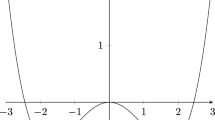Abstract
A Functional Strong-Law-of-Large-Numbers (known as fluid limit or fluid approximation) and a Functional Central Limit Theorem (known as diffusion approximation) are proved for both open and closed networks of multi-server queues in heavy traffic. The fluid limit is a reflected piecewise linear deterministic process, and the diffusion limit is a reflected Brownian motion; both limiting processes are on the nonnegative orthant for open networks and on the nonnegative unit simplex for closed networks. The results generalize the existing ones for networks of single-server queues.
Similar content being viewed by others
References
F. Baskett, K. M. Chandy, R. R. Muntz, and F. G. Palacios. Open, closed and mixed networks of queues with different classes of customers.J. ACM, 22:248–260, 1975.
P. Billingsley.Convergence of Probability Measure. Wiley, 1968.
H. Chen and A. Mandelbaum. Stochastic Leontief systems in continuous time. To appear in M. H. A. Davis and R. J. Elliott, editors,Proceedings of the Imperial College Workshop on Applied Stochastic Processes. Gordon and Breach Science, 1990.
H. Chen and A. Mandelbaum. Discrete flow networks: Bottleneck analysis and fluid approximations.Math of OR, 16:408–446, 1991a.
H. Chen and A. Mandelbaum. Stochastic discrete flow networks: Diffusion approximations and bottlenecks.The Annals of Probability 19:1463–1519, 1991b.
H. Chen and W. Whitt. Diffusion approximations for open queueing networks with service interruptions.Queueing Systems, 13:335–359, 1993.
J. Dai.Steady-State Analysis of Reflected Brownian Motions: Characterization, Numerical Methods and Queueing Applications. Ph.D. dissertation, Dept. of Mathematics, Stanford University, 1990.
J. Dai and J. M. Harrison. Steady-state analysis of RBM in a rectangle: Numerical methods and a queueing application.Annals of Appl. Prob., 1:16–35, 1991.
J. Dai and J. M. Harrison: Reflected Brownian motion in an orthant: Numerical methods for steady-state analysis.Annals of Appl. Prob. 2:65–86, 1992.
C. Flores. Diffusion approximations for computer communications networks. In B. Gopinath, editors,Computer Communications, Proc. Symp. Appl. Math., pp. 83–124. American Mathematical Society, 1985.
P. M. Glynn. Diffusion approximations. In D. P. Heyman and M. J. Sobel, editors,Handbooks in Operations Research and Management Science, Vol. 2 ofStochastic Models. North-Holland, 1990.
P. W. Glynn and W. Whitt: A central-limit-theorem version ofL=λW.Queueing Systems, 2:191–215, 1986.
J. M. Harrison and A. J. Lemoine. A note on networks of infinite-server queues.J. Appl. Prob., 18:561–567 1981.
J. M. Harrison and V. Nguyen. The QNET method for two-moment analysis of open queueing networks.Queueing Systems, 6:1–32, 1990.
J. M. Harrison and M. I. Reiman. Reflected Brownian motion on an orthant.The Annals of Probability, 9: 302–308, 1981a.
J. M. Harrison and M. I. Reiman. On the distribution of multi-dimensional reflected Brownian motion.SIAM J. Appl. Math., 41:345–361, 1981b.
J. M. Harrison and R. Williams. Brownian models of open queueing networks with homogeneous customer populations.Stochastics, 22:77–115, 1987
J. M. Harrison, R. Williams, and H. Chen. Brownian models of closed queueing networks.Stochastics and Stochastic Reports, 29:37–74, 1990.
D. L. Igelhart and W. Whitt: Multiple channel queues in heavy traffic, I.Adv. Appl. Prob., 2:150–177, 1970a.
D. L. Igelhart and W. Whitt. Multiple channel queues in heavy traffic, II.Adv. Appl. Prob., 2:355–364, 1970b.
D. P. Johnson.Diffusion Approximations for Optimal Filtering of Jump Processes and for Queueing Networks. Ph.D. dissertation, University of Wisconsin, 1983.
F. P. Kelly.Reversibility and Stochastic Networks. Wiley, 1979.
A. J. Lemoine. Network of queues—A survey of weak convergence results.Management Science, 24:1175–1193. 1978.
R. Loulou. On the extension of congestion theorems to multi-channel systems. 1974.
G. F. Newell.Applications of Queueing Theory. Chapman and Hall, 1982.
W. P. Peterson. A heavy traffic limit theorem for networks of queues with multiple customer types.Math. of OR, 16:90–118, 1985.
M. I. Reiman. The heavy traffic diffusion approximation for sojourn times in Jackson networks. In R. L. Disney and T. J. Ott, editors,Applied Probability Computer Science, The Interface, II, pp. 409–422. Birkhauser, Boston, 1982.
M. I. Reiman. Open queueing networks in heavy traffic.Math. of OR, 9:441–458, 1984.
H. L. Royden.Real Analysis. Macmillan, NY, 1988.
J. G. Shanthikumar and D. D. Yao. Stochastic monotonicity in general queueing networks.J. Appl. Prob., 26:413–417, 1989.
A. V. Skorohod. Limit theorems for stochastic processes.Theor. Prob. Appl., 1:261–290, 1956.
A. V. Skorohod. Stochastic differential equations for a bounded region.Theor. Prob. Appl., 6:264–274, 1961.
W. Whitt. Heavy traffic theorems for queues: A survey. In A. B. Clark, editor,Mathematical Methods in Queueing Theory. Springer-Verlag, 1974.
W. Whitt: Some useful functions for functional limit theorems.Math. of OR, 5:67–85, 1980.
W. Whitt. On the heavy-traffic limit theorem forGI/G/∞ queues.Adv. in Appl. Prob., 14:171–190, 1982.
P. Yang.Pathwise Solutions for a Class of Linear Stochastic Systems. Ph.D. disseration, Department of Operations Research, Stanford University, 1988.
H. Zhang, G. Hsu, and R. Wang. Strong approximations for multiple channel queues in heavy traffic.J. Appl. Prob., 27, 1990.
Author information
Authors and Affiliations
Rights and permissions
About this article
Cite this article
Chen, H., Shanthikumar, J.G. Fluid limits and diffusion approximations for networks of multi-server queues in heavy traffic. Discrete Event Dyn Syst 4, 269–291 (1994). https://doi.org/10.1007/BF01438710
Received:
Revised:
Issue Date:
DOI: https://doi.org/10.1007/BF01438710



